Article date 5 November 2019
Administrative revision 30 November 2021
Welcome to our research into travel in the Oxford to Cambridge arc.
This article provides a review of current plans for rail travel and airport connections in the Oxford to Cambridge arc. Initially we will review planned development of the rail network then also consider airport connections. We will consider possible additional rail connections. By the use of illustrations, we hope this review is readable.
Our discussion of southern options for the central section of the Oxford to Cambridge arc also discusses the Watford Junction to St Albans Abbey branch railway line.
This review is lengthy. Summary conclusions are available at the end.
This is part one of our review. The part one summary conclusions are reviewed and modified in part two and the conclusions in part two are then reviewed and modified in part three. We recommend reading part three before deciding how much of this part to read.
There is discussion concerning a suitable route for a railway line between Oxford and Cambridge. For a route via London, passengers from Oxford travel to Paddington, taking a train from King's Cross or Liverpool Street to arrive at Cambridge. Additionally, Chiltern Railways provides a route from Oxford to Marylebone via Bicester.
However, the focus of discussion is on a route serving towns in the Oxford to Cambridge arc i.e. not via London and known as east west rail. This discussion is being hosted by the East West Rail Consortium (EWRC).
Here is an overview of travel between Oxford and Cambridge :
Drawings (diagrammatic maps) are displayed full size for clarity.

Source : East West Rail Consortium website.
The discussion concerning rail travel divides into three sections. The western section is basically Oxford to Bedford via Bicester and Bletchley. After some years of discussion, the disused railway line from Bicester to Bletchley is being brought back into use and with an upgraded line from Aylesbury this will, more or less, complete the western section.
The central section is Bedford to Cambridge and is the subject of much discussion.
The eastern section is the continuation of train services from Cambridge to Norwich and Ipswich and the infrastructure for this is essentially already in place.
During discussion of the western section over some years, plans were put in place for anticipated rail services :
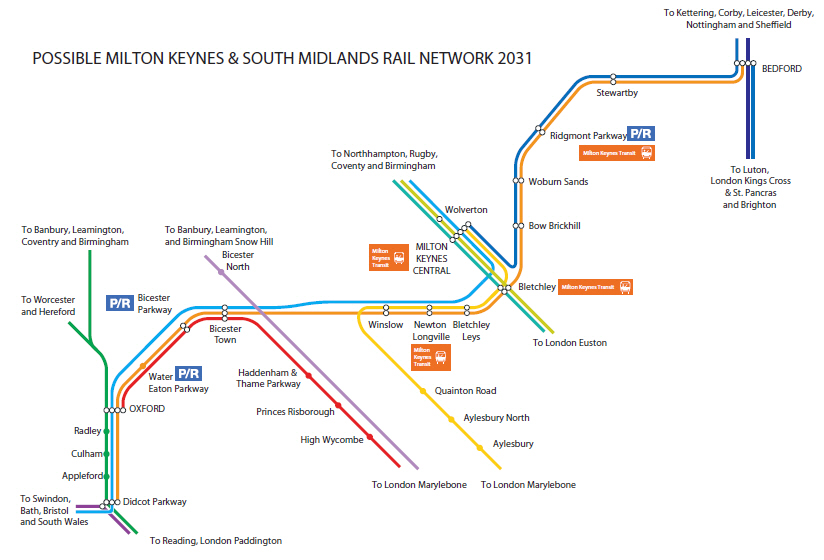
Source : East West Rail Consortium website, schematic_milton_keynes_south_mid.pdf.
Downloaded from the EWRC website in 2009, there have been changes since these plans were put in place. These include, we understand, in the stations served by East West Rail (EWR) between Bedford and Bletchley and in the destinations of these services. A service is planned from Milton Keynes via Aylesbury, Princes Risborough and High Wycombe to Old Oak Common for interchange with Crossrail. A chord at Bletchley enabling a service from Bedford to Milton Keynes is no longer planned.
Let us now consider the east west rail central section i.e. Bedford to Cambridge and which will be the primary focus of our discussion.
Referenced discussion papers, research papers and engineering reports are available here : Referenced papers and reports
In February 2009 consultants Steer Davies Gleave published a discussion paper "East West Rail Central Section - Operating Case". The core of the discussion concerned options for a choice between two corridors for the central section, labelled Central Options and Southern Options :
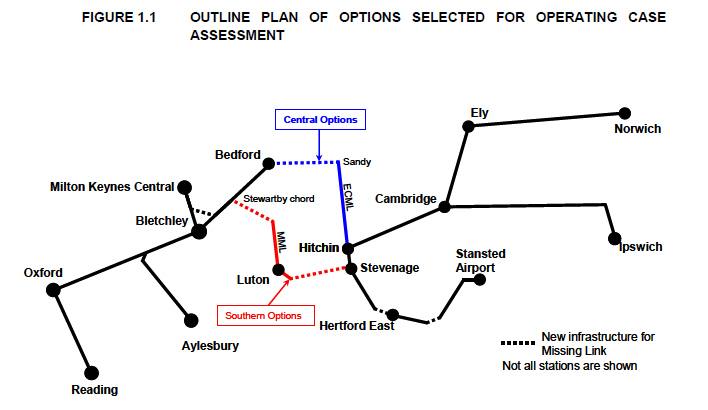
Source : East West Rail Consortium website, discussion paper February 2009, figure 1.1.
The Central Options for the central section required a new alignment from Bedford to Sandy. Paths (space/time slots) would be required on the East Coast Main Line (ECML) with services from Bedford turning south at Sandy onto the ECML. An alternative was to make use of the former Bedford to Hitchin alignment. The options consisted of services either to Stansted Airport or to Cambridge or to both.
The Southern Options for the central section required paths on the Midland Main Line (MML) and on the ECML with services from Bletchley turning south onto the MML to Luton. A new alignment would be required from Luton and Luton Airport Parkway to Stevenage. As for the Central Options, the options consisted of services either to Stansted Airport or to Cambridge or to both.
The Southern Options required a new alignment in the vicinity of Luton Airport (south east of Luton) but made no assumptions regarding a direct rail connection at the airport itself.
The Southern Options provided an EWR/ECML interchange at Stevenage, being almost certainly the best possible choice of location for an interchange. However this was not straightforward to achieve and required paths for all EWR services on the ECML.
For both the Central Options and the Southern Options, services to Cambridge were via the existing Shepreth branch (SBR) from Hitchin to Cambridge. Services to Stansted Airport anticipated a new connection on to the line from Hertford East and from there a new connection onto the West Anglia Main Line (WAML) northwards to Stansted Airport. However, subsequent to this report in February 2009, it was decided to abandon any hope of east west rail services to Stansted Airport (East West Rail press release 3 March 2010).
Discussion subsequent to this February 2009 discussion paper revealed outstanding questions and which resulted in this discussion paper being put on one side. It was felt that a wider initial discussion of all possible options was needed together with a step-by-step process of refinement, also further analysis of constraints. Nevertheless we note that the February 2009 discussion paper highlighted valid corridor options, a matter that may not have been done justice subsequently. We also appreciated the manner in which financing was considered, by comparing operating costs for train services with estimated revenue. The open approach with the inclusion of aerial photographs of key railway infrastructure was appreciated.
We noted earlier that a chord at Bletchley enabling a service from Bedford to Milton Keynes is no longer planned. This chord is discussed in this February 2009 discussion paper, section 4.35 page 26, the area being shown in an aerial photograph figure 4.1.
Before we turn our attention to other matters, the corridor options for the central section as discussed in the February 2009 discussion paper were illustrated not only in figure 1.1 reproduced above but also on the first page of the report. This illustrates the rail network in this area. (We note that Cambridge has moved further to the north, presumably as a response to global warming.)
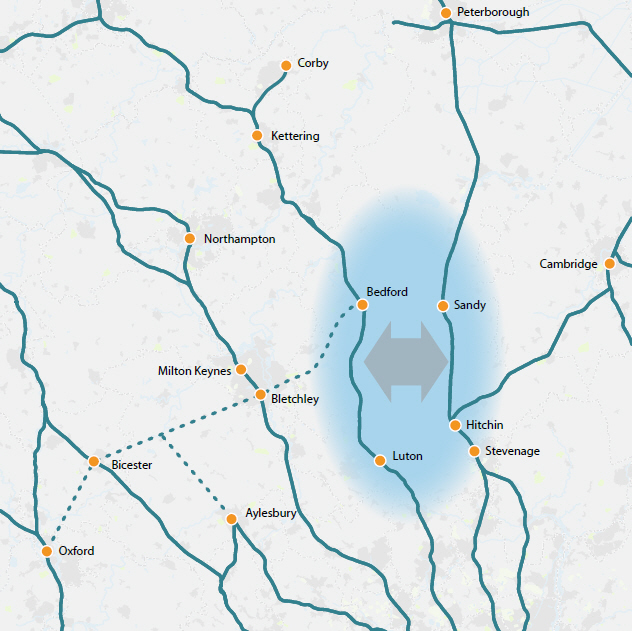
Source : East West Rail Consortium website, discussion paper February 2009, first page.
On 8 August 2014 consultants Atkins published "East West Rail - Central Section Conditional Outputs Statement". Atkins researched the potential for rail travel in the Oxford to Cambridge arc by considering 26 towns and cities as pairs. For example, they determined the potential for travel between Luton and Stevenage and between Oxford and Cambridge. In each case, a direct rail link between the two towns was hypothesised. Comparison could then be made with, for example, journey time by car. Pairs of towns that already have a direct rail link were excluded, for example, travel between Bedford and Luton. With a list of pairs of towns and cities (26 x 26), the results were then ranked, the first two ranks being very high priority journey pairs and high priority journey pairs. The published results included illustrations :
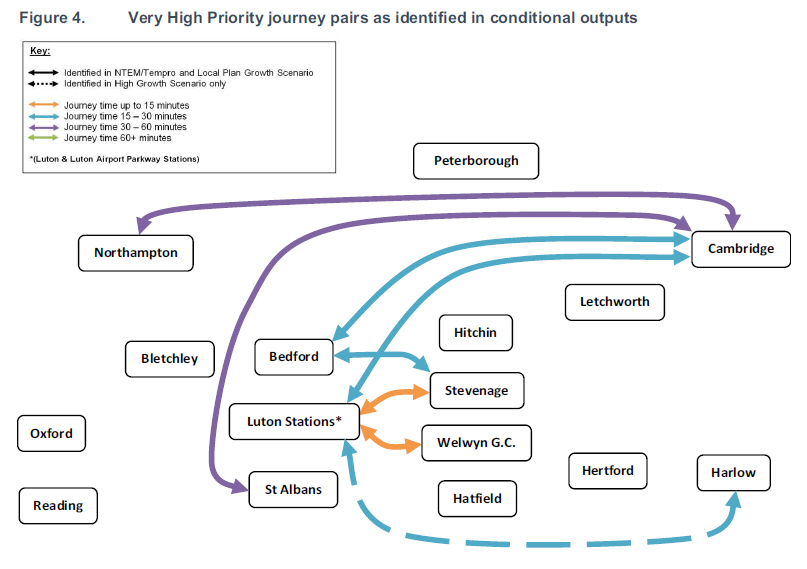
Source : East West Rail Consortium website, research paper August 2014, Figure 4.
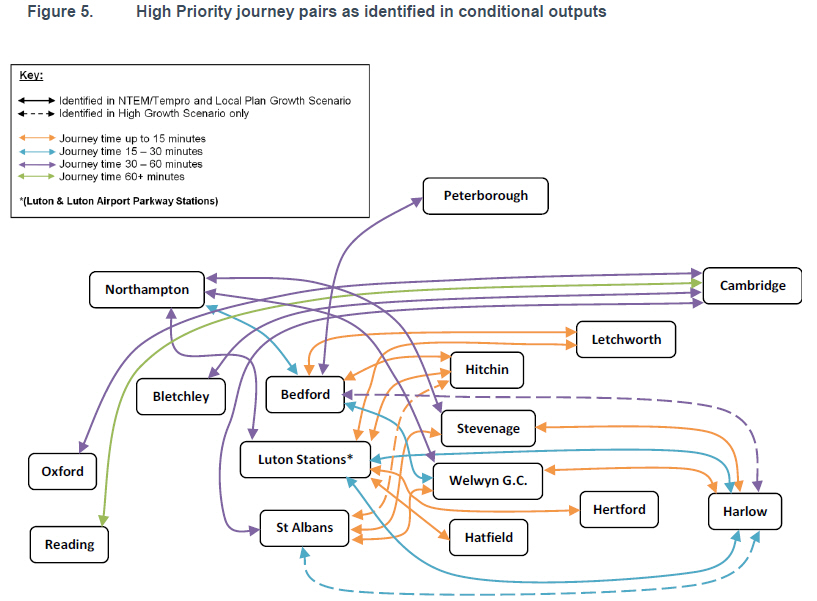
Source : East West Rail Consortium website, research paper August 2014, Figure 5.
The results are interesting. For example, Cambridge to Northampton is a higher priority than Cambridge to Oxford, details on page 64 section 6.1 of the research paper. It is interesting to note the high connectivity results for Harlow.
In section 6.2, we read "What clearly has not been considered at this stage, and which may prove challenging, is the feasibility and deliverability of achieving the target level of connectivity underpinning the analysis presented." Moreover we read (page 19 of the research paper) that "the delivery of a selection of conditional outputs has genuine potential to deliver significant transport user economic benefits, sufficient to support a viable value for money case". In such circumstances, there could be a temptation to simplify the desired outputs, for example to focus primarily on a rail service from Cambridge to Oxford and the journey time to the exclusion of other journey pairs.
On 6 July 2016, consultants Jacobs published "East West Rail Central Section - Engineering Summary Report". Following a wide discussion of potential corridor options, a list of 20 was the starting point. Some options were removed from the list, for example option A Bedford-Kettering-Peterborough-Ely-Cambridge and option B Bedford-Kettering-Peterborough-Sandy-Hitchin-Cambridge.
A number of corridor options via Hatfield and Harlow were excluded, although we might reasonably conjecture these were on the list as a response to the research undertaken by Atkins, considering the very high priority and high priority journey pairs to Harlow. We are uncertain what are the implications of removing corridor options via Hatfield and Harlow at this early stage, although that was the decision taken. This may have been a question of politics, since the boundaries of the Oxford to Cambridge arc have been redefined and now exclude Harlow.
The result was seven corridor options, with an illustration provided.
C1 and C2 Bedford-Sandy-Cambridge,
D Bedford-Sandy-Hitchin-Cambridge,
H2 Bedford-Luton-Stevenage-Hitchin-Cambridge,
M1 Bedford-Hitchin-Cambridge,
M2 Bedford (South) -Hitchin-Cambridge,
N Bletchley-Harlington-Hitchin-Cambridge.
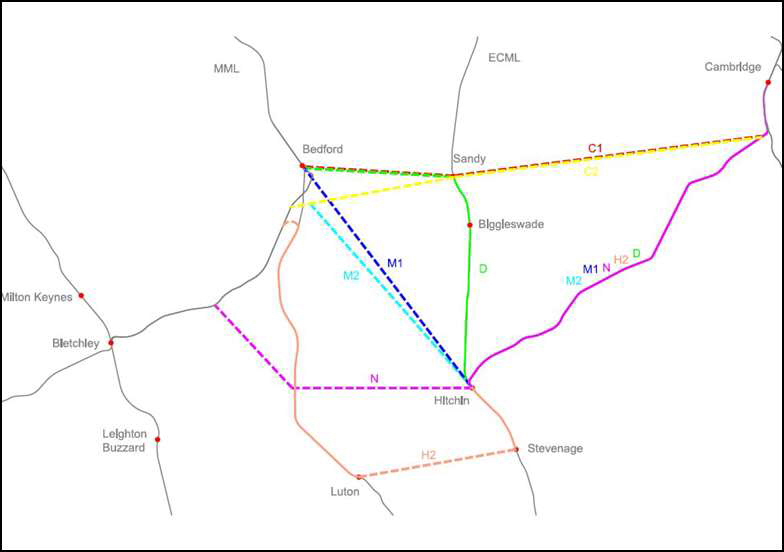
Source : https://www.networkrail.co.uk/our-railway-upgrade-plan/key-projects/east-west-rail/central-section/
Further work narrowed this list down to C1 and C2 via Sandy, and M1 and M2 via Hitchin. Throughout this process of selection, the primary considerations have been journey time between Cambridge and Oxford (or mileage) and railway construction costs. Extensive work was undertaken to decide between C1/C2 or M1/M2 with the results, perhaps unsurprisingly, favouring C1/C2 via Sandy. That is the situation in which we now find ourselves.
Paragraph 79 of the report states "Demand and revenue forecasting computer models for short and long distance journeys indicate that the EWR-CS railway [i.e. east west rail - central section] would generate up to 10,000 additional daily trips in 2031. Cambridge was shown to be a significant generator. The highest potential journey time savings are between Cambridge and Manchester and Cambridge and Birmingham." Paragraph 83 includes " ... work identified that Cambridge - Birmingham and Cambridge - Manchester services were in the top long-distance flows benefiting from EWR."
These journeys from Cambridge to Manchester and Cambridge to Birmingham are via the West Coast Main Line (WCML), that is, the line via Bletchley and Northampton to Birmingham and Manchester. Comparing these journey time savings with the journey pairs from the research undertaken by Atkins, we note that the proposed corridor C1/C2 via Sandy satisfies primarily the potential for rail travel identified as the very high priority journey pair between Cambridge and Northampton. That is great, but what about all the other very high priority and high priority journey pairs ?
Paragraph 87 of the report briefly discusses how to achieve these journeys between Cambridge and Manchester and Cambridge and Birmingham with only one change of train. The question here is that a service from Cambridge to Oxford will call at Bletchley, whereas longer-distance services on the WCML currently call at Milton Keynes but not at Bletchley. The conclusion is that a direct rail service from Cambridge to Milton Keynes would be of benefit, that is, passengers change trains at Milton Keynes for Birmingham or Manchester.
This leads us to an observation. A direct train service from Cambridge to Milton Keynes with passengers from Cambridge to Oxford required to change trains could be of greater value than a direct service from Cambridge to Oxford, should such a choice be necessary. At this stage, this observation does no more than support our stance that there needs to be a careful analysis of journey pairs as an alternative to simplification of desired outputs.
We noted earlier that a chord at Bletchley enabling a service from Bedford to Milton Keynes is no longer planned. This is despite the fact that the Jacobs report suggests that a direct rail service from Cambridge to Milton Keynes would be of benefit. Perhaps there will be consideration given in the future to some longer-distance services on the WCML calling at Bletchley in addition to or in place of Milton Keynes - unknown.
It has been suggested that an interchange with the ECML at Biggleswade would offer better prospects than at Sandy. We understand the town has an established bus network to local towns and villages. Subsequent references in this review to an interchange at Sandy are not intended to preclude an interchange instead at Biggleswade.
At this point it seems reasonable to illustrate the existing rail network, with the proposed corridor C via Sandy shown. There are a number of detailed route options for corridor C. One possibility is for a train from Bletchley to call at the Bedford MML station then continue northwards then eastwards towards Sandy, as distinct from a different station stop in Bedford. Route options could pass to the north or to the south of Sandy. These distinctions have been studied by Network Rail. Whilst appreciating their work, we are here not too concerned about these distinctions in this review. We have chosen to illustrate station stops at Wixams and at Tempsford. Both stations seem to be subject to debate. Responsibility for building the central section railway lies with East West Railway Company (EWR Co) which is not to be confused with the East West Rail Consortium (EWRC).
By reference to the February 2009 discussion paper, the proposed corridor C is a central section central option extended
eastwards to Cambridge, to the exclusion of a southern option. The February 2009 paper discussed this, section 1.5, where
we read
"Consideration was also given to a direct route from Bedford generally routeing via Sandy and across country to Cambridge.
This route would require an additional 20 miles of new alignment east of Sandy. The additional cost of this would [be] very
high, more than doubling the cost and deliverability challenges of any other route. Although the direct journey time to
Cambridge would be the shortest, the passenger interchange opportunities with the East Coast Main Line corridor would be
significantly reduced, effecting the overall demand and viability of the business case. In addition, this route would just
duplicate the existing Hitchin - Cambridge line some 8-10 miles to the south. This route was not pursued further as it was
considered undeliverable predominantly on cost grounds."
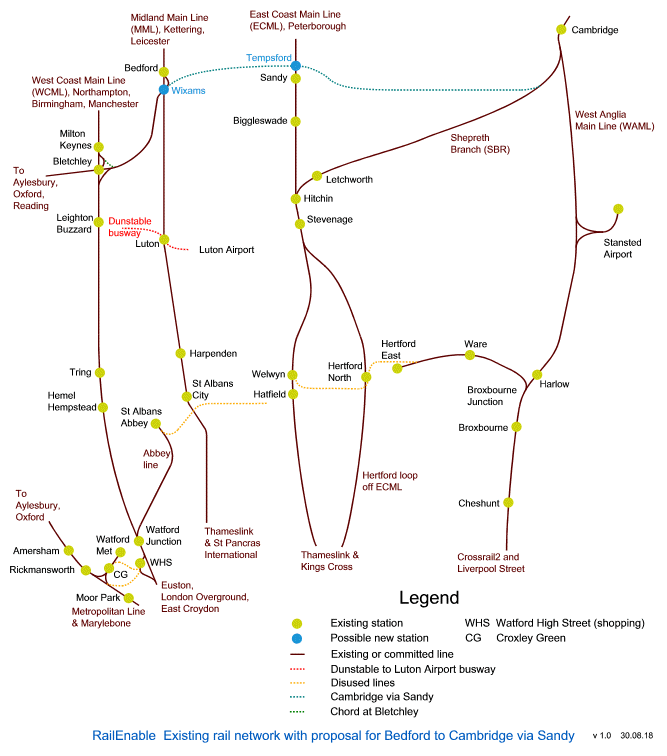
Source : RailEnable
By reference to the diagrammatic map above, it is interesting to review the corridor options via Hatfield and Harlow
the exclusion of which was documented in the Jacobs report. In fact all corridor options via Hatfield were excluded. They
were :
J Bedford-Luton-St Albans- Hatfield- Welwyn GC-Stevenage-Hitchin-Cambridge,
K Bedford-Luton-St Albans- Hatfield- Harlow-Bishops Stortford-Cambridge,
L1 Bedford-Luton-Stevenage-Hatfield- Harlow-Cambridge,
L2 Bedford (South)-Luton-Stevenage-Hatfield- Harlow-Cambridge.
Given the terminology of central section "Central Options" and "Southern Options", we are uncertain what would have been the terminology for corridor options via Hatfield.
We stated earlier that the boundaries of the Oxford to Cambridge arc have been redefined and now exclude Harlow. This is as reported by the National Infrastructure Commission interim report into the Cambridge Milton Keynes Oxford corridor (section 1.3 page 17, Referenced papers and reports ) :
The Cambridge-Milton Keynes-Oxford corridor ... encompasses Daventry and Wellingborough to the north and is bounded on its southern fringe by Luton, Stevenage and Aylesbury Vale.
In the 2016 consultation Cambridge - Milton Keynes - Oxford: 'growth corridor' call for evidence
( Source :
https://www.gov.uk/government/consultations/cambridge-milton-keynes-oxford-growth-corridor-call-for-evidence )
the questions include
"Does the Cambridge - Milton Keynes - Oxford area, including Northampton, form a recognizable economic corridor?"
The results of this consultation are documented in "Partnering for Prosperity : A new deal for the Cambridge-Milton Keynes-Oxford Arc" ( Referenced papers and reports ) where we read on page 18 that
"The Cambridge-Milton Keynes-Oxford (CaMkOx) arc is home to 3.3 million people. It stretches around 130 miles from Cambridgeshire, via Bedford and the south east midlands, to Oxfordshire. It forms a broad arc around the north and west of London's green belt, encompassing Northampton, Daventry and Wellingborough to the north, and Luton and Aylesbury to the south." The document also reports a discussion on defining the right planning areas (page 78).
It is unclear why Luton, Stevenage and Aylesbury Vale form the southern boundary. The result is a gap that is neither within the scope of Transport for London (TfL) nor of the Cambridge-Milton Keynes-Oxford corridor. This is particularly sad since it omits existing east-west rail infrastructure. The Croxley rail link project (project commenced, now suspended) extends the Metropolitan line to Watford Junction. Use of an unused chord would enable Rickmansworth to Watford Junction. There is an existing line from Watford Junction to St Albans Abbey. Why is existing east-west infrastructure excluded from the studies ? This is particularly unfortunate since we do not have, at this stage, a professional response to the work undertaken by Atkins.
A route via Sandy seems to be assumed even though the process of selection documented by Jacobs is focused on journey time from Cambridge to Oxford with no real attempt to achieve the level of connectivity required for this arc. The National Infrastructure Commission (NIC) has commissioned work by professionals relating to the Oxford to Cambridge corridor, but has simply built on the Jacobs summary report published in July 2016.
Thus in the NIC interim report as above, Figure 10 on page 43 illustrates Oxford to Cambridge via Sandy and in section 4.20 page 49 we read :
Early study work, sponsored by Network Rail, the EWR Consortium and DfT [Department for Transport], has identified a single corridor that would offer best value in the development of this section: running from Bedford to Cambridge via Sandy. As well as enabling rail journeys between Oxford and Cambridge in little over one hour, the development of this corridor could provide a catalyst for development to the south of Bedford, at Sandy, and around Addenbrooks on the south side of Cambridge.
The text references "England Economic Heartland (2016), Planning for Growth: a position statement from England's Economic Heartland Strategic transport Forum" which simply assumes on page 13 Oxford to Cambridge via Sandy ( Referenced papers and reports )
The National Infrastructure Commission Transport workstream ( Referenced papers and reports ) figure 12 page 37 illustrates Oxford to Cambridge via Sandy. In the text following the figure we are told "A preferred corridor via Sandy was announced in March 2016." The Transport workstream studies the basis for an Oxford to Cambridge rail corridor but assumes prior work has been conducted on a rigorous basis even though that does not seem to have been the case.
It seems that Biggleswade is a better candidate than Sandy for an ECML interchange and which seems to confirm that the planning process has been lightweight.
Our 2016 research East West rail (Oxford to Cambridge) : our proposals in 2016 proposed three route options, illustrated below :

Option C of our proposals in 2016 hypothesised a compromise between a Central Option and a Southern Option.
Before continuing our discussion, a note about Thameslink. This is a north-south cross-London service via St Pancras. North of London, services have operated solely on the MML to Bedford. London Kings Cross, the terminus of ECML services, is adjacent to St Pancras. A disused tunnel has been brought back into service, resulting in Thameslink services as from 2018 north of London not only on the MML but also on the ECML with services on the ECML to Peterborough and to Cambridge.
The situation in which we find ourselves, at this stage, is that corridor C via Sandy is the proposed corridor for the central section of the east west rail network in the Oxford to Cambridge arc. However, we find ourselves concerned that we may have made insufficient effort to respond to the potential for rail travel identified by means of journey pairs, as published in 2014.
We propose therefore at this point to undertake a straightforward analysis of the published journey pair results. Indeed, we will consider no more than the very high priority journey pairs. The illustration was included earlier and is included here again :

The Cambridge to Northampton journey pair has already been discussed and is satisfied by the selection of a central option for the central section, albeit with a chord missing at Bletchley, also Bedford to Cambridge, two pairs in total. However there are other journey pairs which would seem to be satisfied by the selection of a southern option for the central section, being Bedford to Stevenage, Luton stations (i.e. Luton and Luton Airport Parkway) to Cambridge, to Stevenage, to Welwyn and to Harlow, five pairs in total. This casual analysis suggests potentially stronger revenue for a southern option compared with a central option.
We note that there is little overlap between these two options and we therefore hypothesise the provision of both a central option and a southern option, that is, the apparent possibility for these two to coexist, each satisfying a specific market although, in such a case, there would be some competition between them, for example for travel between Cambridge and Oxford.
At this point our straightforward analysis has revisited the debate between a central option and a southern option and added the suggestion of potential coexistence of both. The observant will note that we have omitted a very high priority journey pair thus far : St Albans to Cambridge. This is not obviously satisfied by either a central option or a southern option. In other words, we could be having the wrong debate. Perhaps we need to move the goalposts.
At this point, we asked ourselves a "What if ?" question. What if we deliberately attempted to satisfy the significant potential for direct rail travel from St Albans to Cambridge ? This resulted in the hypothesis of a railway line from Harpenden via Luton Airport to Hitchin. In an attempt to extend this to provide a central section east west line, i.e. between Oxford and Cambridge, it seemed reasonable to include a connection to the Bletchley to Bedford line and with a bypass of Luton Airport for Bletchley to Hitchin, coloured green below. Here was the result :
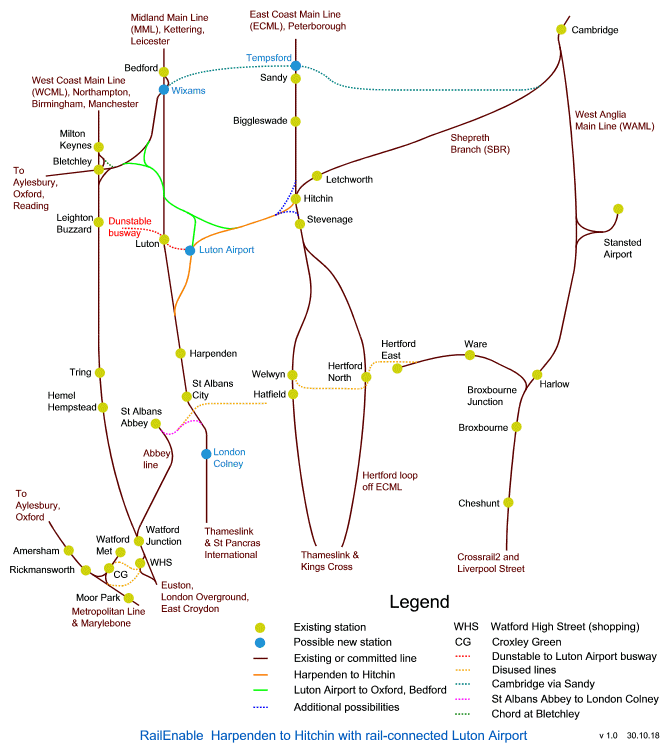
Source : RailEnable
We are aware that there are potential difficulties in pathing services between Hitchin and Cambridge on the Shepreth Branch (SBR), that even the mix of non-stop, semi-fast and stopping services in the 2018 Thameslink timetable is only just feasible.
The obvious service to make use of the line from Harpenden to Hitchin would be a Thameslink service. We therefore hypothesise a Thameslink service to Cambridge via St Albans, albeit with a longer journey time for commuters to London compared with a journey via Welwyn. Ideally this service would be additional to then-current Thameslink services. We hypothesise a service from Oxford to Luton Airport and Hitchin.
Possibly a Thameslink service might operate via Luton Airport to Bedford.
Potentially longer-distance services on the MML might operate via Luton Airport. Alternatively Luton Airport Parkway, which is to the south of Luton station on the MML, with the shuttle currently under construction from this station to the airport (Luton DART), would be retained.
A service via St Albans, Luton Airport and Sandy to Cambridge could be envisaged, connecting on to the Bletchley - Bedford line then via Wixams. Such a service would not require paths on SBR and would seem to be worth considering.
We have been aware for some time of the difficulty of east west rail travel in Hertfordshire, to some extent beyond the scope of Oxford to Cambridge deliberations, it seems. The hypothesised Thameslink service via St Albans to Cambridge would seem to enable additional east west rail journeys in Hertfordshire but not from Watford Junction. In addition to our hypothesis of a railway line from Harpenden to Hitchin, we conjecture an extension of the Watford Junction to St Albans Abbey branch railway line to a new station at London Colney or Napsbury on the MML. Trains would change direction at St Albans Abbey.
We also began to review the potential for rail travel to airports. We were motivated by the observation of high connectivity results for Harlow as part of journey pair analysis and without provision for this thus far, also the exclusion of Stansted Airport at an earlier stage. This resulted in an optional extension of the Harpenden to Hitchin line either to an interchange on the WAML at an existing unspecified station, labelled station X, to enable Harlow journeys or continuing further to Stansted Airport. We also hypothesise a new station on this line. Here it is illustrated :
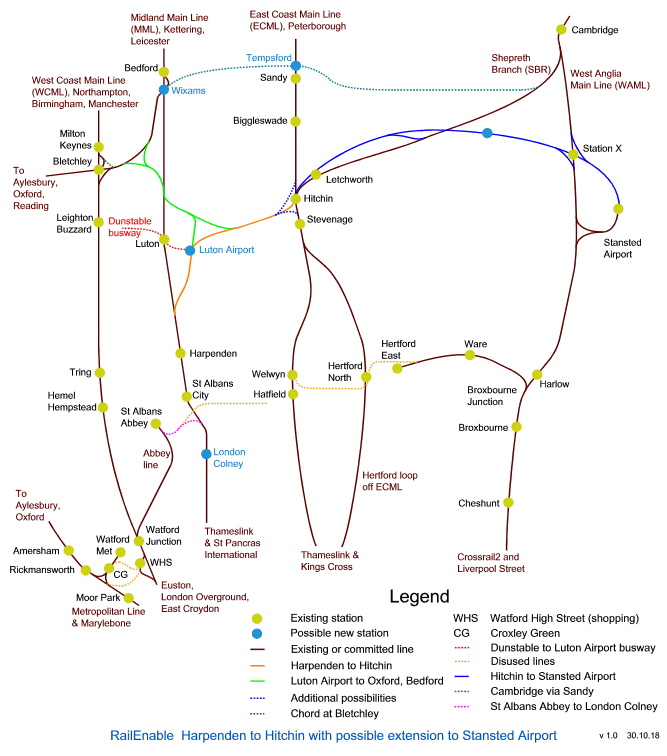
Source : RailEnable
At this point, we have undertaken a review of plans for rail travel and airport connections in the Oxford to Cambridge arc and discussed a Harpenden to Hitchin corridor. Further details follow. We will then discuss a Luton Airport to Stevenage corridor.
We will now discuss journey opportunities in a generic manner.
When consultants Atkins researched the potential for rail travel in the Oxford to Cambridge arc, they determined the potential for rail travel between each pair of towns. In each case, a direct rail link between the two towns was hypothesised. Comparison could then be made with, for example, journey time by car. However no one would envisage a rail network providing direct links between each pair of towns and so choices have to be made. Where as a result of choices made there is no direct rail link, the potential for travel between two such towns still exists. Without a direct rail link, we can still ask how the journey would be undertaken, what the journey time might be and how many changes are needed to accomplish it. In other words, it is worthwhile to study each very high priority and high priority journey pair as a journey opportunity, whether or not a direct rail link is provided. A list of journey opportunities is available here : Central section journey pairs (pdf format).
In considering journey opportunities it would seem reasonable to make no distinction between travel by rail or travel by bus/coach, provided the latter is satisfactory. The criteria for satisfactory travel by bus/coach could be listed. We hypothesise the following criteria : clean, safe, reliable, comfortable, uncrowded and on a congestion-free route.
We note that some buses set off from bus stops before passengers who have boarded have sat down and, conversely, that it is necessary for passengers to move to the exit prior to arrival at their destination bus stop. We regard these as unsatisfactory for bus/coach travel that is regarded as being on a par with rail travel. Not only do we regard these arrangements, if that is what they are, as unsatisfactory but also as primary reasons for not travelling by bus at all. However there are likely to be differing opinions on this matter, particularly when buses attempt to compete with cars on the basis of journey time.
We have here discussed journey opportunities in a generic manner. If the corridor C via Sandy proposed railway line and our hypothesised line from Harpenden to Hitchin were to be evaluated, it would be worthwhile to list the very high priority and high priority journey pairs as a list of journey opportunities and use that list as a basis. This would seem to provide a reasonable starting point firstly for determining service provision and then for estimating daily trips, operating costs and revenue. This is a similar exercise to the work that was undertaken by consultants Atkins in 2014 but with proposals for the rail and bus/coach network in place of a set of hypothesised direct rail links.
Such a method of evaluation and in a politically neutral atmosphere, i.e. without assumptions designed to favour any particular result, is preferable to doing no more than estimating construction costs and Oxford to Cambridge journey times. We are expressing here the hope of work conducted to professional standards.
A significant proportion of commuter journeys to London are by rail. This is not surprising considering the many railway lines into London and the significant number of stations in London. In contrast, we would not expect this pattern to be repeated in other towns or cities that do not have multiple railway stations and in proximity to work areas. Even with improved rail links between Oxford and Cambridge we would not anticipate a significant increase in commuting to work by rail.
There is already crowding at busy railway stations including Oxford, Cambridge, Bedford, Banbury and Milton Keynes (National Infrastructure Commission Transport workstream as earlier section 2.7.3 page 26, Referenced papers and reports ). Although these railway stations are busy, this does not indicate that commuting by rail forms a significant proportion of commuter journeys.
In contrast, conventional buses or coaches are more flexible. Collection points can be selected to suit passengers and set-down points can be selected to suit destinations i.e. work areas. We therefore hypothesise that, even with a railway line between Oxford and Cambridge and where there is an increase in commuter journeys by public transport, there is potential for a significant increase in the use of buses and coaches, that is, provided that congestion-free routes are available.
The working assumption of car travel has been of complete flexibility however this is increasingly being called into question particularly in large conurbations. Park and ride schemes and congestion charging are well known. We hypothesise that this paradigm shift may extend further. Thus for example we might in the future envisage roads that are designed specifically to enable congestion-free bus and coach travel but which are also used by those for whom the roads are appropriate e.g. residents along the route. In other words, we have hypothesised limited-access long-distance roads.
As a general point, how would such limited-access long-distance roads be planned ? The stages in planning would, we suggest, be from the least flexible to the most flexible.
A rail network is inflexible whereas a road network is flexible. Moreover, at this time, railway lines are considered to be expensive. Bus and coach routes are more flexible than train services but only operate effectively on congestion-free routes. Hence we suggest the following stages in planning transport links :
Stage 1 is to plan the rail network.
Stage 2 is to plan long-distance bus and coach routes. This is effective when designed as a response to journey opportunities which are not satisfied by the rail network. Therefore this stage is subsequent to stage 1. It is of course possible indeed likely that operators will compete with the rail network however that is additional : the priority at stage 2 is bus and coach routes that complement the rail network.
Stage 3 is to plan the road network, both limited-access congestion-free routes and the general-purpose free-for-all road network including trunk roads.
To add an additional question concerning the planning of significant conurbations, that is, beyond the desirable characteristic of being rail-centric on an existing railway line, it is generally assumed that the rail network can be extended to suit additional conurbations wherever they are located. We would express doubts as to whether this method of working will always be successful. We would suggest it is always worthwhile to consider new conurbations that fit in with the existing rail network. Hence, for example, our willingness earlier to hypothesise a new conurbation at London Colney with a new station stop on the MML. As a general point, the planning of new conurbations is perhaps best achieved in conjunction with a good understanding of the characteristics, purpose and scope of the rail network.
It is not unknown for housing estates to be directly connected by links only available for buses, coaches and cyclists. A limited-access long-distance road is an extension of this idea i.e. extended beyond built-up areas. It is not purely a bus/coach route and is available for all registered road users because their journey is appropriate via this route.
We might for example envisage a limited-access road between Bedford and Cambridge, distinct from an Oxford - Cambridge Expressway. Bus/coach services would reasonably include Cambridge - Bedford and Cambridge - Milton Keynes although these would compete with a Bedford - Sandy - Cambridge rail corridor.
There may be extensive new housing in Central Bedfordshire e.g. in the vicinity of Tempsford. This would seem to suggest an approach of coordinating a new railway line with new housing developments and which serve to ensure that the railway line is well patronised. However, such housing developments necessitate reasonable road links to Bedford and to Cambridge and which have the potential to compete with the railway line. A decision to deliberately plan unsatisfactory road links to Bedford and to Cambridge could help protect the railway line however any such decision could subsequently be reversed. We do not think that estimates of daily journeys, revenue and costs on a Bedford - Sandy - Cambridge railway line can reasonably be regarded as reliable without considering competition by road.
If a Bedford - Sandy - Cambridge railway line is to be constructed, it might be helpful if it were planned to enable subsequent conversion to form the basis for a conventional road.
We have hypothesised a line from Harpenden to Hitchin with an ECML interchange at Hitchin. An alternative could be for the line to bypass Hitchin, for example with there being no station stop between Luton Airport and Letchworth. In this case we would hope for a means of travel between stations on the ECML and Luton Airport. Thus we would anticipate either (i) a service from Peterborough via Luton Airport, presumably a Thameslink service, using a north-to-west chord in the vicinity of Hitchin or (ii) a service via Welwyn and Stevenage to or via Luton Airport, using a south-to-west chord in the vicinity of Hitchin.
Cambridge to Northampton is a very high priority journey pair, discussed earlier, resulting in an anticipated service from Cambridge to Milton Keynes. Welwyn to Northampton and Stevenage to Northampton are both high priority journey pairs, therefore in case (ii) above we might anticipate services via Welwyn and Stevenage to Luton Airport and Milton Keynes. There is potentially a case for such services even if there is an interchange at Hitchin.
Continuing the discussion above, we note that Welwyn to Luton and Stevenage to Luton are both very high priority journey pairs. There may therefore be a good case for providing a busway directly from Welwyn to Luton and from Stevenage to Luton. Perhaps the latter of these might run alongside the Luton Airport to Hitchin line for part of its length.
The following high priority journey pairs Luton - Northampton, Northampton - Stevenage and Northampton - Welwyn would seem also to imply, to continue an earlier point, journeys to Birmingham and Manchester via the WCML requiring a change of train at Milton Keynes. Hence we might envisage two bus/coach services : Milton Keynes to Luton/Luton Airport and Welwyn, Milton Keynes to Luton/Luton Airport and Stevenage.
We now illustrate a line from Harpenden passing to the north of Hitchin without a passenger interchange at the point where the line crosses the ECML.
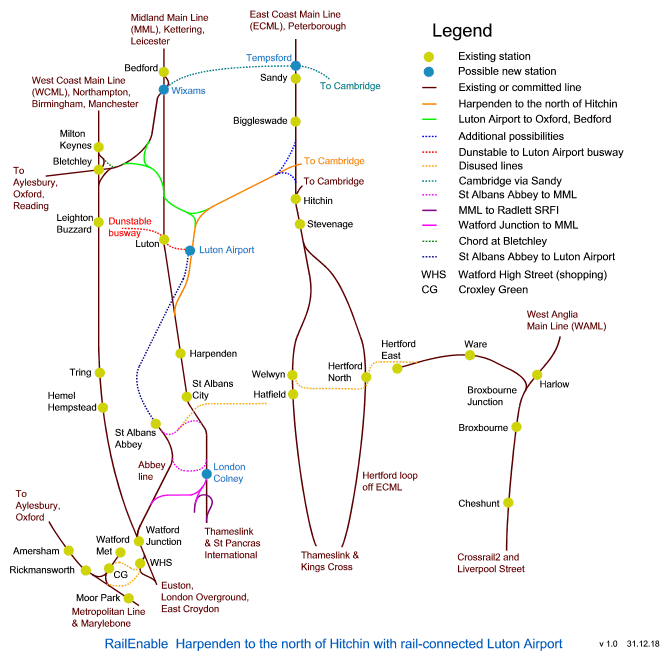
Source : RailEnable
We have not illustrated the new line in relation to the Shepreth branch, for example, whether Letchworth would be a station stop on the line from Harpenden.
A train service via Welwyn and Stevenage to Luton Airport would also serve Hitchin.
In considering a Harpenden - Hitchin corridor, we do well to have regard for interchange arrangements with the ECML, including the possibility of EWR services connecting onto the ECML and bus/coach services via Stevenage and via Welwyn.
There is an error in our above illustration and in earlier illustrations : Croxley Green should be Croxley. Did you notice ?
It seems reasonable to us to consider east west rail travel in Hertfordshire as being within the scope of the Oxford to Cambridge arc.
The Watford Junction to St Albans Abbey branch line, the Abbey line, is underutilised. How to make better use of this line has been a matter of debate for many years. The debate has included whether or not to convert to light rail. One possibility we might envisage would be light rail from Watford and St Albans Abbey to Hatfield and perhaps to Hertford, making use of dismantled lines, probably with on-street running in Hatfield and not necessarily calling at Hatfield station.
An asset of the Abbey line is the location of St Albans Abbey station. Given that the city is built on a hill, neither this station nor St Albans (City) station is located in the city centre. It is possible to walk from the Abbey station to the city centre without having to walk up Holywell Hill, either by means of minor roads or via Verulamium park opposite.
Earlier we hypothesised an extension of the Abbey line to a new MML station stop at London Colney or Napsbury. This could be as conventional rail or light rail.
In our diagrammatic map above, although this need not apply solely in the case of a line from Harpenden passing to the north of Hitchin, we have illustrated a possible extension of the Abbey line northwards from St Albans Abbey to Luton Airport, although this extension would pass through or in proximity to Roman Verulamium. There is an existing rail service from East Croydon via Kensington Olympia and Watford Junction to Milton Keynes. An extension of the Abbey line to Luton Airport would reasonably provide a secondary route from East Croydon via Kensington Olympia, Watford Junction and St Albans Abbey to Luton Airport, the primary route being via Thameslink.
Earlier we envisaged a service via St Albans, Luton Airport and Sandy to Cambridge, connecting on to the Bletchley - Bedford line then via Wixams. This might be a service from East Croydon via Kensington Olympia, Watford Junction, St Albans Abbey, Luton Airport and Sandy to Cambridge. This assumes both an extension of the Abbey line to Luton Airport and the green-coloured lines on our diagrammatic maps connecting on to the Bedford to Bletchley line.
Although an express line between Luton Airport and Heathrow would seem unlikely, a line from Luton Airport towards St Albans Abbey station could form the commencement of such a line.
Earlier we referred to plans that were put in place for services on the western section. This illustration was included earlier and is included here again, not least since we enjoy the colours :

A service between Oxford and Aylesbury would be possible, requiring a connecting chord from the Bicester - Bletchley line on to the line to Aylesbury. By reference to our diagrammatic maps, continuing south from Aylesbury and by use of the Croxley rail link, a service would be possible to Watford Junction. If a crossing over or under the WCML at Watford Junction were constructed, a service would be possible on the Abbey line to St Albans Abbey, Luton Airport and, if paths were available on the SBR, to Cambridge. The result is a service between Oxford and Cambridge via Watford Junction. This service does not operate via Bletchley, using as an alternative a WCML interchange at Watford Junction. This service does not require the green-coloured connecting lines on our diagrammatic maps between the Luton - Hitchin corridor and the Bletchley to Bedford line.
As part of the Croxley rail link project, we suggest the terminus of the Metropolitan line remaining at Watford (Met) instead of being relocated to Watford Junction would not seem to represent any significant disadvantage. By means of an EWR service from Watford Junction, change at Chalfont and Latimer for the Metropolitan line.
The Croxley rail link is also known as the Metropolitan line extension, however we suggest its construction for reasons unrelated to any extension of the Metropolitan line and therefore refer to this project as the Croxley rail link.
The Croxley rail link or Metropolitan line extension is also known as the western Watford Sustainable corridor.
Radlett Strategic Rail Freight Interchange (SRFI), included on our diagrammatic map for Harpenden to the north of Hitchin, is discussed later in this article. We have also hypothesised and illustrated a link line from Watford Junction to the MML for St Albans (City). On a north-east orientation from How Wood station on the Abbey line there used to be a rail link to the MML at Napsbury and built to mainline standards. There is still evidence of it. It was provided to enable construction traffic for what is now the MML via the Abbey line, which was pre-existing at that time.
As an alternative to a new line between St Albans Abbey and Luton Airport, an Oxford to Cambridge route via the MML might then be envisaged by means of such a link line from Watford Junction to the MML for St Albans (City), Luton Airport Parkway and Luton, Wixams by means of a partial implementation of the green-coloured connecting lines, Tempsford, Cambridge.
Also included on our diagrammatic map for Harpenden to the north of Hitchin, an alternative means of connection to the MML might be envisaged by means of a direct connection between St Albans Abbey and St Albans (City), requiring a change of direction at St Albans Abbey. This would be envisaged as entirely to the north of the North Orbital road A414 or entirely to the south. In either case, we note that the existing line on approach to St Albans Abbey is single track and that upgrading this to dual track (north of How Wood station) would almost certainly not be justified. The result is that a connection between St Albans Abbey and St Albans (City) could not support any greater frequency than 2 trains per hour in each direction and we would not specifically advocate construction of such a connection. We code-name this route "St Albans Abbey & City" and regard it as unlikely. However we return to this in part two.
We have three possible routes for a service between Oxford and Cambridge via Luton Airport : a route via Bletchley probably requiring a change of direction at Luton Airport, a route via Watford Junction with a new line from St Albans Abbey to Luton Airport and a route via Watford Junction connecting on to the MML.
When comparing these routes, it should be borne in mind that our diagrammatic maps are intended to illustrate railway infrastructure and are not to scale. The rail network illustrated on the first page of the February 2009 discussion paper and reproduced earlier shows Aylesbury, Bletchley and Luton. It illustrates that Oxford, Aylesbury, Luton and Stevenage to Cambridge is a very reasonable proposal. Although it does not show the Croxley rail link to Watford nor the Watford to St Albans branch line, it would seem to be to scale. A new line from Luton Airport connecting on to the Bedford to Bletchley line to Bletchley would be longer than a new line from Luton Airport to St Albans Abbey station.
The high priority journey pair Bedford - Northampton implying onward travel to Birmingham or Manchester by changing trains at Milton Keynes would seem to imply either a train or a bus/coach service between Bedford and Milton Keynes.
Given that Cambridge - Luton is a very high priority journey pair, there is the possibility of some services via St Albans to Cambridge via Luton rather than via Luton Airport. However, journeys to Cambridge would typically begin by travelling to Luton station and perhaps travelling to Luton Airport would be a reasonable alternative.
With reference to our previous diagrammatic map, a railway line between Luton and Stansted airports offers the prospect of coordination between the two airports. We might envisage a dedicated train service with dedicated platforms at both airports, the airports offering guaranteed transfer times between flights, automatic rebooking in the event of delay to an incoming flight and automatic relabelling of baggage. That is, the facilities that we would expect at a modern airport where multiple runways are served from a single passenger area.
It may be that there is potential for flights to a limited selection of destinations in the US, either from Luton or from Stansted, with connecting flights at both Luton and Stansted airports, a minor hub airport pair offering limited competition with Heathrow. We also note an anticipated direct train service between Luton and Gatwick airports i.e. Thameslink.
Without extension beyond Hitchin of the Harpenden to Hitchin line, we might hypothesise Crossrail 2 extended to Harlow, enabling passengers from Harlow to change at the Crossrail 2 combined Euston/Kings Cross/St Pancras station for Thameslink services from St Pancras. That is, limited provision for Harlow journeys with only one change of train albeit in London.
As an alternative to an extension of services via Luton Airport to station X on the WAML and possibly to Stansted Airport, we might hypothesise a branch from the WAML in the vicinity of station X to an interchange station on the Shepreth branch. There might then be a service from Liverpool Street to this interchange station. Passengers from Harlow would change at this interchange on the Shepreth branch for east west rail services.
Our article Camberley : coming in from the cold proposes a London commuter service via Bagshot, Camberley and Frimley.
The July 2016 Jacobs report cited earlier hypothesises a service from London Paddington via Oxford to Cambridge. As an alternative to this, we hypothesise a circular service between Oxford, London and Cambridge operating both clockwise and anticlockwise. The route would be Oxford, Reading, Wokingham, Bracknell, Bagshot, Camberley, Frimley, Woking, Crossrail 2, Harlow, Cambridge where the train would change direction, Luton Airport, Oxford. This would provide many new journey opportunities, also for Harlow.
With a connection northwards from Stansted Airport to the WAML, trains could be routed via Stansted Airport. This would provide a direct service between Stansted Airport and Luton Airport.
We hypothesise that such a service might contribute to a reduction in car dependency and of congestion on the M25 motorway.
RailEnable is proposing Aylesbury Interchange (AI) as a station stop on the High Speed 2 railway line (article : Proposal for Aylesbury Interchange on High Speed 2 ).
A variation of our hypothesised circular service between Oxford, London and Cambridge would operate via AI.
Earlier we commented that Stevenage was almost certainly the best possible choice of location for an EWR/ECML interchange.
We have considered a Harpenden to Hitchin corridor, on an alignment either via Hitchin or to the north of Hitchin. To the south of Hitchin is Stevenage. It seems that an EWR/ECML interchange at Stevenage would be the best choice : as for Hitchin, all trains on the ECML including the Hertford loop and on the SBR run via Stevenage, however Stevenage is also a significant interchange station. Here is a Luton Airport - Stevenage corridor illustrated :

Source : RailEnable
Potentially a service from Oxford can approach Stevenage either from the north, a west-to-south connection, with possible continuation to Kings Cross, or from the south, a west-to-north connection, with possible continuation to Cambridge via the SBR, in either case subject to path availability.
Infrastructure possibilities at Stevenage were briefly discussed in the February 2009 discussion paper sections 4.39, 4.40 but with different objectives.
We have illustrated a possible method for an optional extension to Stansted Airport and with a facility-rich interchange with the WAML, being a railway roundabout. We are unaware at the time of writing of any other suggestion for a railway roundabout, other than the BBC TV series of this name : this is not an invitation to enjoy steam trains.
For those who have not been distracted by steam trains, the alternative would be for services from Oxford via Stevenage to connect on to the SBR. Additional tracks between Stevenage and Hitchin could be investigated and, if not feasible, we might envisage a new connecting line on to the SBR. This is a built-up area and it is likely that tunnelling would be needed. Engineering considerations apply particularly in relation to tunnelling. Given the capital cost, we suggest that Oxford to Cambridge via Stevenage is effectively a separate proposal from Oxford to Stevenage, for which services either terminate at Stevenage or continue southbound on the ECML.
Nevertheless it would seem appropriate to plan a full implementation i.e. Oxford to Cambridge via Stevenage prior to partial implementation i.e. Oxford to Stevenage. Some or all EWR services would reasonably call at Hitchin with existing services on the SBR that do not call at Hitchin making use of the new connection.
If such a service operated via Watford Junction, the interchanges on an Oxford to Cambridge service would be :
Chalfont and Latimer for Marylebone (passengers from Watford, direct service available at Oxford)
Chalfont and Latimer for Metropolitan line
Watford Junction for the WCML and other connections
Luton Airport for the MML : if services on the MML remained unchanged, passengers would appreciate being able to use the
shuttle under construction between Luton Airport and Luton Airport Parkway
Stevenage for the ECML.
As an alternative to a service via Stevenage, elements of a Luton Airport - Stevenage corridor and a Harpenden - Hitchin corridor could be combined, offering the possibility of Oxford to Stevenage and Oxford to Cambridge via Luton Airport not via Stevenage.
At this point we would like to make a suggestion. It might be reasonable to plan a two trains per hour Oxford to Cambridge service via Luton Airport and preferably via Stevenage with a review of Thameslink services to enable this. If the results were considered unsatisfactory, to plan upgrades to the rail network specifically to enable satisfactory Thameslink services operating with this Oxford to Cambridge service. That is, it is a matter of perspective.
On the site of the former Radlett aerodrome alongside the MML, a strategic rail freight interchange (SRFI) i.e. freight terminal is proposed. The proposers have provided an illustrative masterplan Illustrative Masterplan and a site location plan Site Location Plan (both open in a new window or tab).
Objectors to the proposal have a facebook page at facebook.com/Stop-The-Rail-Freight-Exchange-STRiFE-102211233181381/
As illustrated by one of the two maps, the SRFI includes a west-to-south connection on to the MML i.e. towards St Pancras and which we have included on our diagrammatic maps.
How Wood station on the Abbey line is at the left-hand extremity of the red lines demarking the two areas labelled as 5. On a north-east orientation from How Wood station is the dismantled link to Napsbury referenced earlier. Built to mainline standards, there is still evidence of it. It was provided to enable construction traffic for what is now the MML via the Abbey line, which was pre-existing at that time.
The link to Napsbury is documented in the book "The Watford to St Albans Branch", formerly published by Oakwood Press now incorporated into Stenlake Publishing . This is one of the carefully researched and insightful series of books known as the Locomotion Papers. (A list of page references for the link to Napsbury in this book : 6, 19, 79, 80, 104.) At the time of writing, the publisher's webpage for this book was located at Watford to St Albans Branch (both open in a new window or tab).
The book has been updated in the second edition by Geraint Hughes, who was Passenger Transport Policy Manager for Hertfordshire County Council from 1991 to 2005. The book documents, until 2008, the history of the line and of the campaign to secure its future. It makes interesting reading. At the time of publishing, the expectation was that a passing loop would be added at Bricket Wood, at the mid-point of the line from Watford to St Albans Abbey, enabling two trains to pass, thus enabling service frequency to be increased.
There is also a reference online to the dismantled link to Napsbury as a contractors connection at
www.disused-stations.org.uk/s/st_albans_london_road/
Park Street station was subsequently relocated and is shown at its former location i.e. in the vicinity of the present-day
How Wood station.
A map showing the dismantled link to Napsbury can be viewed by typing in How Wood Station at streetmap.co.uk and selecting Zoom Level 3. The link continued in a north easterly direction over the terrain flattened to become the former Radlett aerodrome i.e. where the construction of Radlett SRFI is proposed.
Although not planned by the proposers of the SRFI, we have included on our diagrammatic maps a west-to-north connection on to the MML, i.e. towards St Albans (City) and which connects on to the Abbey line to provide Watford to St Albans (City). This is as an alternative to the west-to-south connection on to the MML as proposed. Freight trains would access the SRFI either southbound on the MML via St Albans (City) or indeed northbound on the MML via London and by use of a purpose-built turnback siding, or northbound on the WCML via London, Watford Junction and the connection from the Abbey line.
At this point, we will focus on a Luton Airport to Stevenage corridor but leave aside a direct Oxford to Cambridge service either via Stevenage or via a Harpenden - Hitchin corridor, that is, we will leave aside Oxford to Cambridge via Luton Airport. Oxford to Cambridge can be achieved by changing at Stevenage. Cambridge to Luton Airport can also be achieved by changing at Stevenage.
A Luton Airport to Stevenage corridor without infrastructure for Oxford to Cambridge via Luton Airport can coexist with a Bedford - Cambridge corridor and therefore offers the prospect of proceeding with both in parallel.
An Oxford to Stevenage service either via Bletchley or via Watford Junction might be anticipated. This would provide an EWR/ECML interchange at Stevenage for services to Oxford. A consequence of this is that the location of the ECML interchange on the Bedford - Cambridge corridor is of less significance, whether at Sandy or at Biggleswade, although Biggleswade would seem to be the better candidate.
A Thameslink service from the MML to Luton Airport might be anticipated. A Thameslink service from the ECML to Luton Airport might be anticipated. These two potentially combine to provide a circular Thameslink service via Luton Airport.
A service from East Croydon via Kensington Olympia was outlined earlier. Probably not all of these services would be provided.
Without an Oxford to Cambridge service via Luton Airport and to avoid more than one change for some journeys e.g. Bedford - Letchworth, a coach service Luton and Luton Airport to Hitchin and Letchworth could be worth considering. Bedford - Letchworth is then achieved by changing at Luton. We discussed earlier St Albans and Luton to Cambridge via the Bedford - Cambridge line.
Earlier we outlined a service between Oxford, London and Cambridge capitalising on our proposal Camberley : coming in from the cold for a London commuter service via Bagshot, Camberley and Frimley. This was a circular service via Crossrail 2. Here we will outline a service that does not make use of Crossrail 2 and which is not a circular service.
From London Waterloo, the service operates either via Richmond and Staines or via Woking and Camberley to Bracknell, Wokingham, Reading and Oxford then either via Bletchley or via Aylesbury, Wendover, Amersham, Chalfont and Latimer then, via the Croxley rail link, Watford Junction and St Albans to Luton Airport, Stevenage, Welwyn and London Kings Cross. This offers a service to Waterloo, a service to Kings Cross and an orbital service.
A service via Aylesbury would take longer than via Bletchley because it would serve additional centres of population and so would offer additional journey opportunities and therefore potentially greater benefits. A service via Aylesbury might coexist better than a service via Bletchley with a Bedford - Cambridge rail corridor.
Consider for example how a journey would currently be undertaken between Wokingham and Wendover or Woking and Wendover, by changing trains at Waterloo and at Marylebone. For passengers with access to a car, use of the car seems more probable than changing trains twice. With a direct rail service between the stations we have selected as examples, use of a train service becomes more probable. We conjecture that the circular service outlined earlier between Oxford, London and Cambridge and this service between Waterloo and Kings Cross have the potential to contribute to a reduction in congestion on roads including the M25 motorway and with consequential economic benefits.
A service via Watford Junction interchanges with the WCML there, with an earlier discussion concerning station stops for longer-distance services substituting Watford Junction for Bletchley. A question is how desirable is a journey from Welwyn to Birmingham or Manchester by changing at Watford Junction compared with changing at Bletchley.
This service offering connections both to Waterloo and to Kings Cross that did not exist previously, there is the possibility of some passengers using this service as a means to avoid or reduce use of the London Underground including at peak times, thus contributing to a reduction in congestion on the Underground.
With a Waterloo via Oxford and Stevenage to Kings Cross service, let us now envisage scenarios to address central section journey opportunities. Let us assume that services on the MML are unchanged, that Luton Airport Parkway station remains open and that services on the MML call at this station as currently. Let us assume that services on the ECML remain unchanged, albeit with the addition of our service via Oxford connecting on to the ECML at Stevenage for Kings Cross. The new station at Luton Airport is served solely by a Waterloo to Kings Cross service.
As discussed earlier, complementary bus/coach services might be anticipated to include Luton and Luton Airport to Hitchin and Letchworth.
If services on the MML remained unchanged, passengers would appreciate being able to use the shuttle under construction between Luton Airport Parkway and Luton Airport, that is, to facilitate their journey rather than to take a flight from the airport. It is unlikely the shuttle would be used extensively by London commuters : for St Pancras, remain on the train to arrive at Kings Cross, which is adjacent; for Thameslink, change at Stevenage. We might envisage access to the shuttle being limited according to ticket to exclude journeys for which its use is superfluous.
We might envisage two scenarios : Waterloo to Kings Cross via Bletchley, Waterloo to Kings Cross via Aylesbury. Central section journey opportunities could then be assessed : Central section journey pairs (pdf format) although journeys beyond the scope of the Atkins central section study are also enabled.
At this point in our review, there are other scenarios that could be envisaged.
In Modern Railways magazine May 2018, EWR Chairman Rob Brighouse challenges the assumption of using the Marston Vale line i.e. Bletchley to Bedford for east west rail and has mooted the possibility of building a new line from Milton Keynes northbound and then east to Bedford. In this scenario, services between Oxford and Cambridge would run via Milton Keynes. The proposal has our support.
Mr Brighouse comments on the Oxford to Cambridge line that "It's prime purpose is as a commuter service linking homes and jobs. The key is having competitive journey times between key centres - I don't see journeys from Oxford to Cambridge as the only or in fact the core use of the line."
Hertfordshire rail strategy dated June 2016 ( Referenced papers and reports ) informs us, page 56, that a top priority in the long term is to "Develop local east-west rail connectivity in the north of the county through new infrastructure" and on page 58 "Investigate local rail-based solutions for improved connections to Luton Airport from north Hertfordshire towns."
We have asked no undergraduates for their perspective on rail travel between Oxford and Cambridge. However we might guess what some points of view might be. Firstly, this is not the Oxford to Cambridge high-technology arc. It is the Oxford versus Cambridge high-tension arc. Secondly, there is no provision for a train race between Oxford and Cambridge universities.
These are the interim conclusions to part one of our research. These conclusions are reviewed and modified in part two and the conclusions in part two are then reviewed and modified in part three.
When consultants Atkins published research into the potential for rail travel in the central section of the Oxford to Cambridge arc, they studied journey pairs. The results were then ranked, the first two ranks being very high priority journey pairs and high priority journey pairs. These ranked journey pairs invite us to focus on journey opportunities.
The key rail transport planning discussion in the Oxford to Cambridge arc for some years has been between "Central Options" and "Southern Options". A compromise between these could be, as outlined earlier, option C of our proposals in 2016. If a "Central Option" is to be implemented, we might envisage a parallel "Southern Option".
If plans are to proceed for a railway line Oxford - Bedford - Cambridge, i.e. a Central Option, then we might envisage a parallel railway line Oxford - Hitchin or Oxford - Stevenage. Of these two, Oxford - Stevenage would seem to be a better choice since it would provide the Oxford - Cambridge corridor with a strategic interchange between the ECML and Oxford, i.e. for which Stevenage would seem to be the better candidate.
A railway line Oxford - Stevenage would either be via Bletchley or via Watford Junction. A route via Watford Junction would probably entail lower capital costs, benefit from a better business case due to the intermediate towns served and better complement an Oxford - Bedford - Cambridge line.
To repeat a point made earlier, when comparing routes, it should be borne in mind that our diagrammatic maps are intended to illustrate railway infrastructure and are not to scale. The rail network illustrated on the first page of the February 2009 discussion paper and reproduced earlier shows Aylesbury, Bletchley and Luton. It illustrates that Oxford, Aylesbury, Luton and Stevenage to Cambridge is a very reasonable proposal. Although it does not show the Croxley rail link to Watford nor the Watford to St Albans branch line, it would seem to be to scale. A new line from Luton Airport connecting on to the Bedford to Bletchley line to Bletchley would be longer than a new line from Luton Airport to St Albans Abbey station.
As a partial compromise between a Southern Option and a Central Option, we have hypothesised a possible route via Luton
Airport Parkway on the MML and Bedford. The route is
Oxford, Aylesbury, Rickmansworth, Watford Junction, St Albans (City), Luton Airport Parkway, Luton, Bedford (or Wixams), Cambridge.
This serves some southerly towns but with routing via a
Central Option alignment. We take the opportunity to recall the Atkins very high priority pair between St Albans and
Cambridge. With a Luton Airport to Stevenage corridor we have a possible route
Oxford, Aylesbury, Rickmansworth, Watford Junction, St Albans (City), Luton Airport, Stevenage.
These two routes could potentially operate concurrently.
A summary illustration of our conclusions follows. Although we illustrated earlier an optional extension to Stansted Airport, this is considered unlikely and is omitted. We also illustrated earlier a possible tunnel for connection via Stevenage to the SBR and, at the conclusion of this review, we propose to omit this tunnel from our summary illustration. Luton Airport Parkway and Luton to Bedford (or Wixams) for Cambridge is retained, but not Luton Airport to Oxford or Bedford. We have retained Luton to Oxford although there has been no discussion of a service that might make use of this.
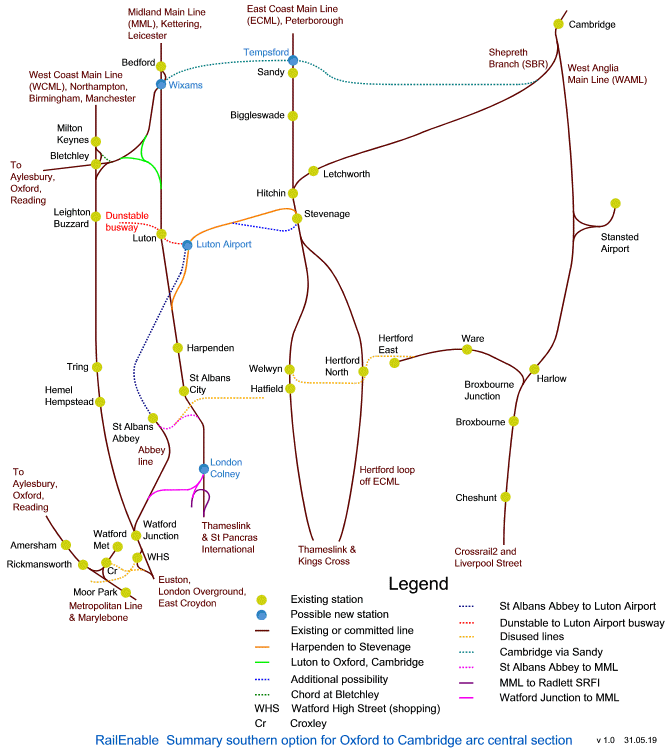
East west rail at Watford is the subject of a specific article and which forms part two of this review : Oxford to Cambridge : east west rail at Watford
The views expressed in this review are those of RailEnable.
Limited on-site investigations have been conducted in relation to this article.
RailEnable home page
Text is copyrighted. Copyright RailEnable. All rights reserved.
RailEnable illustrations are copyrighted. Copyright RailEnable. All rights reserved.
Illustrations by East West Rail Consortium are copyrighted by East West Rail Consortium.
"East West Rail Central Section - Engineering Summary Report" is copyrighted by Jacobs.